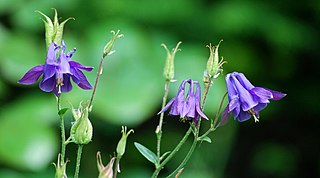
Aquilegia is a genus of about 130 species of perennial plants that are found in meadows, woodlands, and at higher elevations throughout the Northern Hemisphere, known for the spurred petals of their flowers.
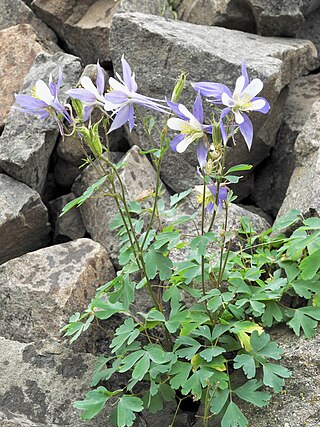
Aquilegia coerulea, the Colorado columbine, Rocky Mountain columbine, or blue columbine, is a species of flowering plant in the buttercup family Ranunculaceae, native to the Rocky Mountains and some of the surrounding states of the western United States. It is the state flower of Colorado. The Latin specific name coerulea means "sky blue".
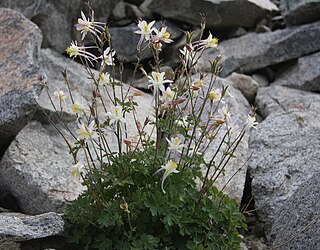
Aquilegia pubescens is a perennial flowering plant in the family Ranunculaceae, endemic to the Sierra Nevada in California. It is usually known by the common name Sierra columbine, and less frequently as the alpine columbine or Coville's columbine.

Aquilegia chrysantha, the golden columbine, is a perennial herbaceous flowering plant native to the southwestern United States and northwestern Mexico. The plant, with a height of between 40 centimetres (16 in) and 120 centimetres (47 in), has yellow flowers. A. chrysantha. as with other members of the Aquilegia coerulea species complex, is evolved for pollination by hawkmoth. It favors moist environments in its mountainous range.

Aquilegia saximontana, the Rocky Mountain columbine, alpine dwarf columbine, dwarf blue columbine, or alpine columbine, is a perennial plant that comes from the buttercup family, Ranunculaceae.
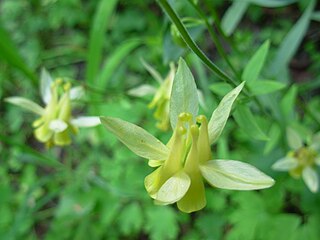
Aquilegia flavescens, the yellow columbine, is a perennial species of flowering plant in the family Ranunculaceae, native to the Rocky Mountains of the United States and Canada.
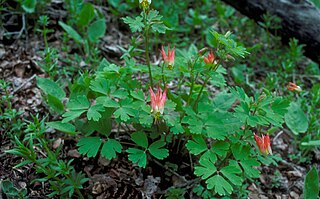
Aquilegia elegantula, the western red columbine, is a perennial species of flowering plant in the family Ranunculaceae, native to the Southwestern United States and northern Mexico.

Hesperidanthus suffrutescens is a species of flowering plant in the mustard family. Its synonyms include Glaucocarpum suffrutescens. When placed in the genus Glaucocarpum, it was the only species. It is a rare species known by the common names toad-flax cress, shrubby reed-mustard, Uinta Basin waxfruit and waxfruit mustard. It is endemic to Utah in the United States, where it is known only from Duchesne and Uintah Counties. It is threatened by habitat degradation and destruction. It is federally listed as an endangered species of the United States.

Aquilegia micrantha var. grahamii, common name Graham's columbine, is a variety of perennial flowering plant in the family Ranunculaceae, endemic to Utah in the United States.

Aquilegia flabellata, common name fan columbine or dwarf columbine, is a perennial herbaceous flowering plant in the family Ranunculaceae, native to North and East Asia.

Aquilegia viridiflora, commonly known as the green columbine or green-flowered columbine, is a perennial flowering plant in the family Ranunculaceae, native to southern Siberia, northern China, Mongolia, and Japan.
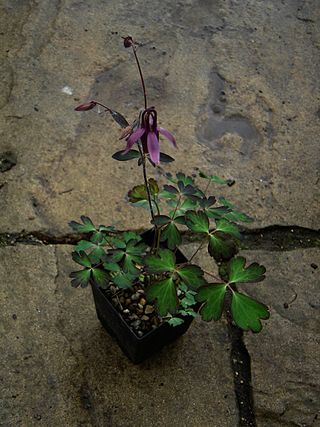
Aquilegia rockii is a perennial flowering plant in the family Ranunculaceae, native to southern China.

Aquilegia parviflora is a species of flowering plant of the Aquilegia (columbine) genus in the family Ranunculaceae native to the Asian regions of Siberia, northern Mongolia, northern China, and Sakhalin.

Aquilegia skinneri, commonly known as the Mexican columbine or Skinner's columbine, is a perennial flowering plant in the family Ranunculaceae, native to Mexico and Guatemala.

Aquilegia confusa is a partially accepted species of flowering plant of the genus Aquilegia (columbines) in the family Ranunculaceae that is endemic to the eastern and southern European Alps in Switzerland and Italy. The entirety of the plant, particularly its seeds, are toxic to humans.

Aquilegia desolaticola, the desolation columbine or Desolation Canyon columbine, is a perennial species of flowering plant in the family Ranunculaceae, endemic to Utah.

Aquilegia micrantha, the Mancos columbine or Bluff City columbine, is a perennial species of plant in the family Ranunculaceae, native to Utah, Colorado, and Arizona.

Penstemon albifluvis, the White River penstemon, is a disputed species or variety of Penstemon that grows in a small area in eastern Utah and western Colorado. It grows mainly on broken shale and rock formations in desert habitats. White River penstemon is very rare.
Aquilegia atwoodii, commonly known as Atwood's columbine, is a perennial flowering plant in the family Ranunculaceae, endemic to Utah.

Aquilegia amurensis is a partially accepted species of flowering plant in the genus Aquilegia (columbines) in the family Ranunculaceae that is native to the northeastern Asian. Its natural range is in the northern Greater Khingan mountain range and Amur River of China, as well as Siberian Russia, Mongolia, and possibly North Korea. Flowers of this plant have petal blades that are whitish or white-tipped, with blue-violet nectar spurs and sepals. The plant is rarely cultivated.




















